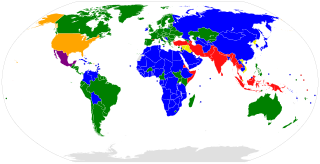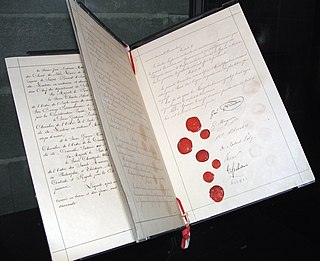Related Research Articles
The Protocol for the Prohibition of the Use in War of Asphyxiating, Poisonous or other Gases, and of Bacteriological Methods of Warfare, usually called the Geneva Protocol, is a treaty prohibiting the use of chemical and biological weapons in international armed conflicts. It was signed at Geneva on 17 June 1925 and entered into force on 8 February 1928. It was registered in League of Nations Treaty Series on 7 September 1929. The Geneva Protocol is a protocol to the Convention for the Supervision of the International Trade in Arms and Ammunition and in Implements of War signed on the same date, and followed the Hague Conventions of 1899 and 1907.

The Geneva Convention relative to the Protection of Civilian Persons in Time of War, more commonly referred to as the Fourth Geneva Convention and abbreviated as GCIV, is one of the four treaties of the Geneva Conventions. It was adopted in August 1949, and came into force in October 1950. While the first three conventions dealt with combatants, the Fourth Geneva Convention was the first to deal with humanitarian protections for civilians in a war zone. There are currently 196 countries party to the 1949 Geneva Conventions, including this and the other three treaties.

The law of war is the component of international law that regulates the conditions for initiating war and the conduct of hostilities. Laws of war define sovereignty and nationhood, states and territories, occupation, and other critical terms of law.

Non-combatant is a term of art in the law of war and international humanitarian law to refer to civilians who are not taking a direct part in hostilities; persons, such as combat medics and military chaplains, who are members of the belligerent armed forces but are protected because of their specific duties ; combatants who are placed hors de combat; and neutral persons, such as peacekeepers, who are not involved in fighting for one of the belligerents involved in a war. This particular status was first recognized under the Geneva Conventions with the First Geneva Convention of 1864.
International humanitarian law (IHL), also referred to as the laws of armed conflict, is the law that regulates the conduct of war. It is a branch of international law that seeks to limit the effects of armed conflict by protecting persons who are not participating in hostilities and by restricting and regulating the means and methods of warfare available to combatants.

Protocol I is a 1977 amendment protocol to the Geneva Conventions concerning the protection of civilian victims of international war, such as "armed conflicts in which peoples are fighting against colonial domination, alien occupation or racist regimes". In practice, Additional Protocol I updated and reaffirmed the international laws of war stipulated in the Geneva Conventions of 1949 to accommodate developments of warfare since the Second World War (1937–1945).

A combat medic is responsible for providing emergency medical treatment at a point of wounding in a combat or training environment, as well as primary care and health protection and evacuation from a point of injury or illness. Additionally, medics may also be responsible for the creation, oversight, and execution of long-term patient care plans in consultation with or in the absence of a readily available doctor or advanced practice provider. Combat medics may be used in hospitals and clinics, where they have the opportunity to work in additional roles, such as operating medical and laboratory equipment and performing and assisting with procedures.

The United Nations Convention on Certain Conventional Weapons, concluded at Geneva on October 10, 1980, and entered into force in December 1983, seeks to prohibit or restrict the use of certain conventional weapons which are considered excessively injurious or whose effects are indiscriminate. The full title is Convention on Prohibitions or Restrictions on the Use of Certain Conventional Weapons Which May Be Deemed to Be Excessively Injurious or to Have Indiscriminate Effects. The convention covers land mines, booby traps, incendiary devices, blinding laser weapons and clearance of explosive remnants of war.

A dazzler is a non-lethal weapon which uses intense directed radiation to temporarily disorient its target with flash blindness. They can effectively deter further advances, regardless of language or cultural barriers, but can also be used for hailing and warning. Targets can include electronic sensors as well as human vision.
The Geneva International Centre for Humanitarian Demining is an international organisation working in mine action and explosive ordnance risk reduction, with a focus on landmines, cluster munitions and ammunition stockpiles. Based in the Maison de la paix in Geneva, it is legally a non-profit foundation in Switzerland.

War can heavily damage the environment, and warring countries often place operational requirements ahead of environmental concerns for the duration of the war. Some international law is designed to limit this environmental harm.
Distinction is a principle under international humanitarian law governing the legal use of force in an armed conflict, whereby belligerents must distinguish between combatants and protected civilians. Combatant in this instance means persons entitled to directly participate in hostilities and thus are not afforded immunity from being directly targeted in situations of armed conflict. Protected civilian in this instance means civilians who are enemy nationals or neutral citizens outside of the territory of a belligerent power.
Air warfare must comply with laws and customs of war, including international humanitarian law by protecting the victims of the conflict and refraining from attacks on protected persons.

An explosive weapon is a weapon that uses an explosive to project blast and/or fragmentation from a point of detonation.

The Geneva Conventions are international humanitarian laws consisting of four treaties and three additional protocols that establish international legal standards for humanitarian treatment in war. The singular term Geneva Convention colloquially denotes the agreements of 1949, negotiated in the aftermath of the Second World War (1939–1945), which updated the terms of the two 1929 treaties and added two new conventions. The Geneva Conventions extensively define the basic rights of wartime prisoners, civilians and military personnel; establish protections for the wounded and sick; and provide protections for the civilians in and around a war-zone.
The Protocol on Prohibitions or Restrictions on the use of Incendiary Weapons is a United Nations treaty that restricts the use of incendiary weapons. It is Protocol III to the 1980 Convention on Certain Conventional Weapons Which May Be Deemed To Be Excessively Injurious Or To Have Indiscriminate Effects. Concluded in 1981, it entered into force on 2 December 1983. As of January 2023, it had been ratified by 126 state parties.

John Marshall MBE, FMedSci, PhD, DSc, FRCPath, FRSB, FRCOphth(Hon), FRCOptom (Hon), FARVO is a British medical scientist and inventor. Currently he is the Frost Professor of Ophthalmology at the Institute of Ophthalmology UCL and Emeritus Professor King's College London. He is a pioneer of laser eye surgery.
New physical principles weapons are a wide range of weapons or systems created using emerging technologies, like wave, psychophysical, and genetic weapons.
In international humanitarian law and international criminal law, an indiscriminate attack is a military attack that fails to distinguish between legitimate military targets and protected persons. Indiscriminate attacks strike both legitimate military and protected objects alike, thus violating the principle of distinction between combatants and protected civilians. They differ from direct attacks against protected civilians and encompass cases in which the perpetrators are indifferent as to the nature of the target, cases in which the perpetrators use tactics or weapons that are inherently indiscriminate, and cases in which the attack is disproportionate, because it is likely to cause excessive protected civilian casualties and damages to protected objects.
References
- 1 2 3 "2 .a Additional Protocol to the Convention on Prohibitions or Restrictions on the Use of Certain Conventional Weapons which may be deemed to be Excessively Injurious or to have Indiscriminate Effects (Protocol IV, entitled Protocol on Blinding Laser Weapons)". United Nations Treaty Collection. 12 November 2021. Retrieved 4 July 2014.
- ↑ "Protocol on Blinding Laser Weapons (Protocol IV to the 1980 Convention), 13 October 1995". International Committee of the Red Cross. Retrieved 4 July 2014.
- 1 2 3 "Vienna Diplomatic Conference Achieves New Prohibition on Blinding Laser Weapons and Deadlock on Landmines". International Committee of the Red Cross. 13 October 1995. Retrieved 4 July 2014.
- 1 2 3 4 5 Carnahan, Burrus M.; Robertson, Marjorie (July 1996). "The Protocol on "Blinding Laser Weapons": A New Direction for International Humanitarian Law". The American Journal of International Law. 90 (3): 484–490. doi:10.2307/2204074. JSTOR 2204074. S2CID 147660010.
- ↑ Marshall, John (29 November 1997). "Blinding Laser Weapons: Still Available on the Battlefield". BMJ: British Medical Journal. 315 (7120): 1392. doi:10.1136/bmj.315.7120.1392. PMC 2127879 . PMID 9418079.